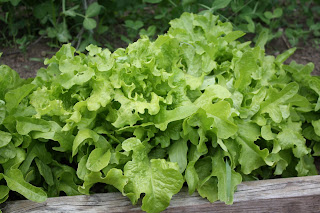Here's a view of the garden taken early this evening:
In the left front corner, behind the fence, is the zucchini. Working toward the right you see parsley, then broccoli and red onions. In the back left corner is the cabbage. Pea pods are straight ahead being picked by my daughter with tomatoes to the right of that. (My kids eat more pea pods raw, right off the vines, then they do cooked). In the middle bed is the post with the hummingbird feeder I wrote about last time. Pole beans have just popped out of the ground and will soon be winding their way up the pole. Around the pole beans are peppers, eggplant, and marigolds. Outside the fence is lined with various flowers- marigolds to deter pests, cleome and cosmos to attract butterflies and hummingbirds, and on the north side (behind the pea pods), sunflowers to attract birds in late summer. In the far back left of the photo, against the building, is our cold frame. We grew arugula and rosemary until mid-December last year, but I need to learn more about maintaining produce all winter long.
I'm thrilled with the results so far, but I want pause to tell you that we have been working on this garden for about 5 years. Our first year was a disaster- the seeds were washed away in heavy rain and rabbits ate all the plants we put in during one night. We gave up that year- we had a young son and it was too much to redo everything. The next year we got smart- built inexpensive raised beds and put a cheap fence around the whole thing. We had more success. Then we put in a real fence with a gate and added more compost to the beds. Terrific success. Then last year... virtually nothing was productive except the basil. It was a bad year.
My message... start small and add to your successes. If you planted a small garden, or in some pots, and had success this year, build on it. If things didn't go quite so well, as with our first year, take a step back and plan for how you'll improve next year. Take baby steps. You know the old saying: Rome wasn't built in a day! It's easy to get caught up in trying to do everything all at once. Cut yourself some slack and celebrate each step you take toward growing your own produce.
Here are some close-ups of the produce:
Cabbage
Eggplant
Romaine Lettuce
Pea Pods
How are your gardening efforts going? Some of you left comments that you were planting this year. Others told me in person. Please share your successes with us. What challenges are you facing?






















